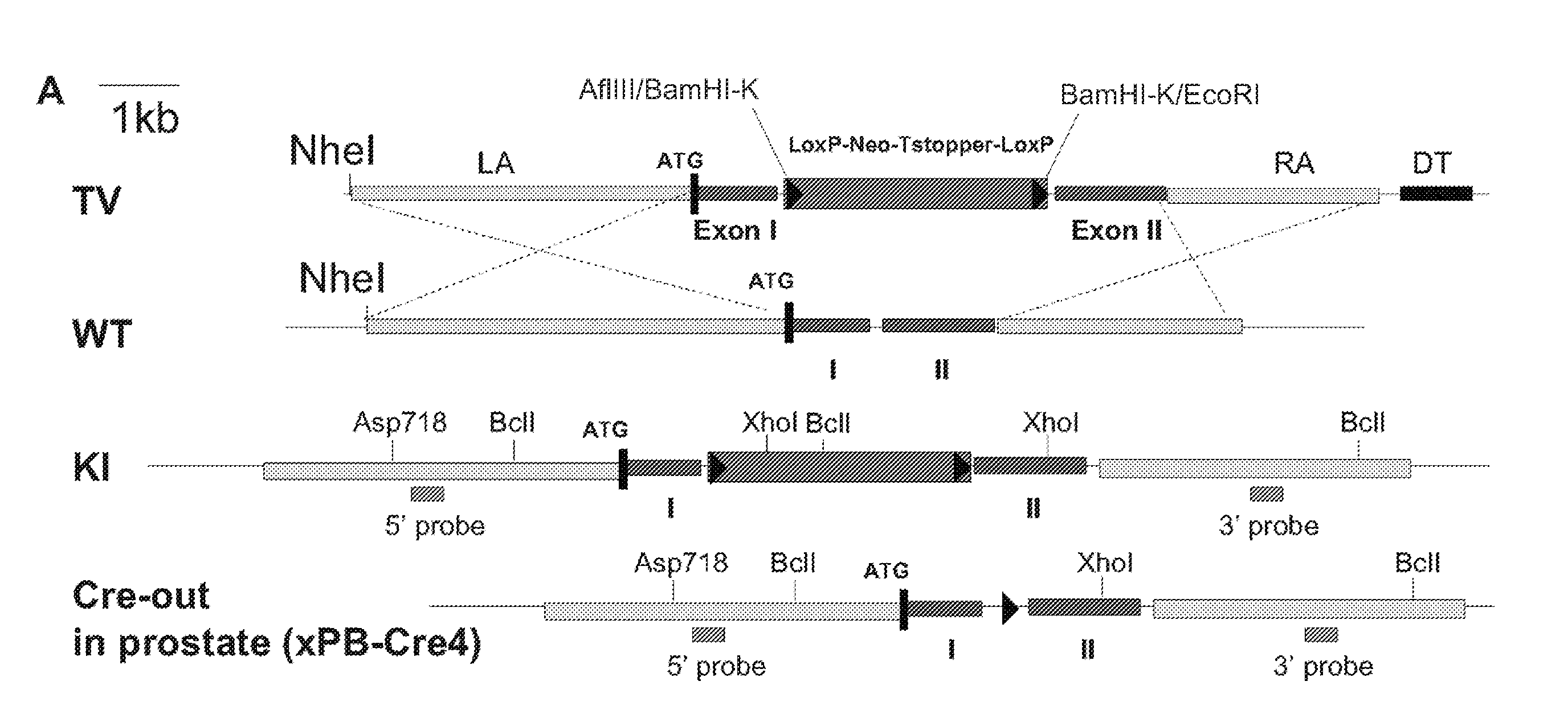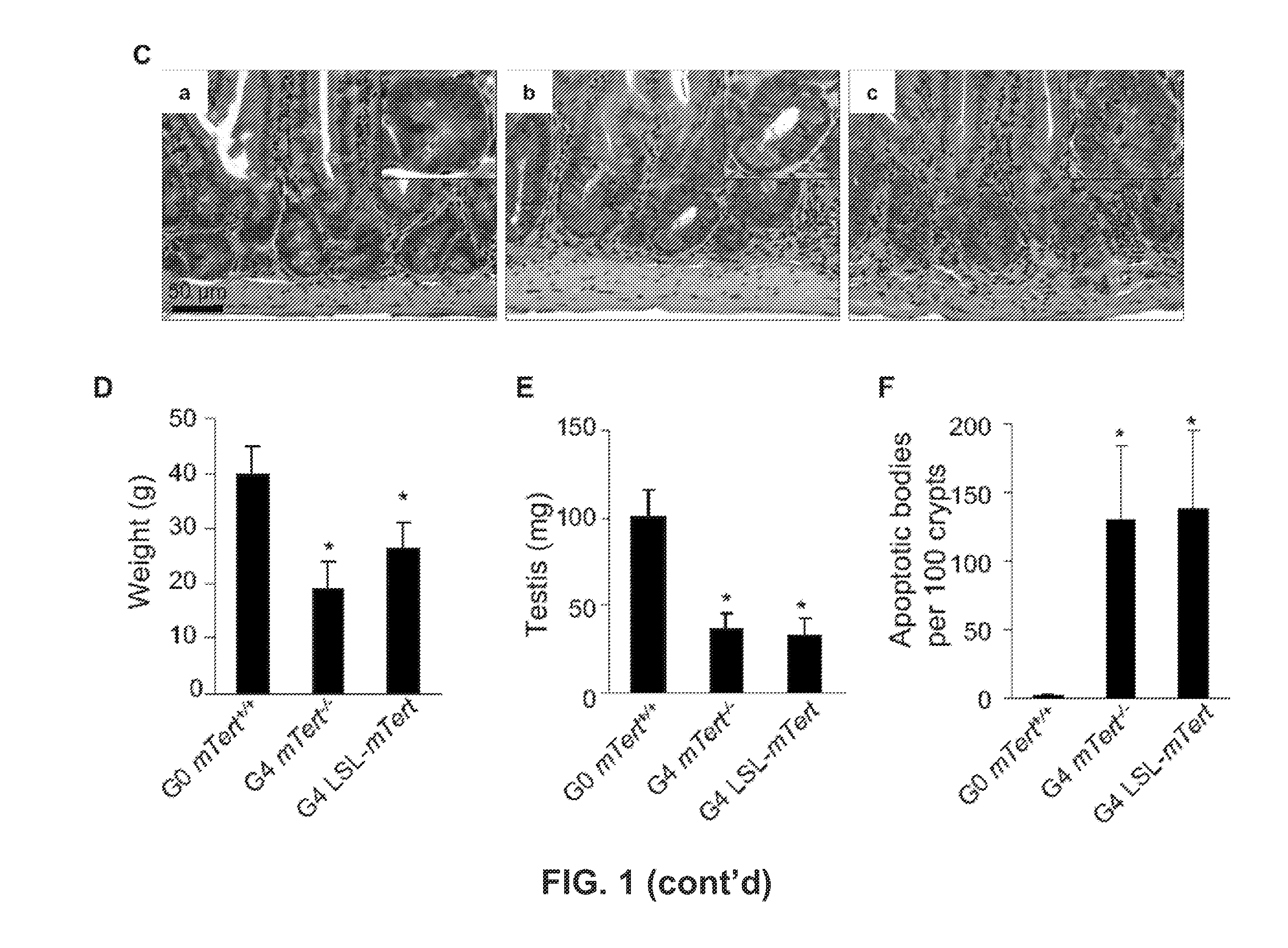Signatures and determinants associated with prostate cancer progression and methods of use thereof
a prostate cancer and determinant technology, applied in the field of signs and determinants associated with prostate cancer progression and methods, can solve the problems of single biomarker utility, inability to reliably link, and inability to fully predict the outcome, and achieve the effect of increasing the susceptibility to metastatic prostate cancer
- Summary
- Abstract
- Description
- Claims
- Application Information
AI Technical Summary
Benefits of technology
Problems solved by technology
Method used
Image
Examples
example 1
General Methods
[0249]mTert Knockout Allele, Pten and Trp53 Conditional Alleles.
[0250]mTert knockout allele and the PtenloxP conditional knockout alleles have been described elsewhere (Zheng et al., Nature (2008), Farazi et al., Cancer Res. (2006)). p 53loxP strain was generously provided by A. Berns (Marino et al., Genes Dev. (2000)). Prostate epithelium-specific deletion was effected by the PB-Cre4 (Wu et al., Mech. Dev. (2001) and was obtained from MMHCC (http: / / mouse.ncifcrf.gov / search_results.asp).
[0251]Generation of the LSL-mTERTloxP Allele.
[0252]We knock-in the LSL cassette into the first intron (FIG. 1A). The presence of the LSL cassette produces a null mTert allele and its removal by PB-Cre expression restores activity under the control of the native mTert promoter. This mouse model scheme allows for excellent specific control telomerase reconstitution in prostate epithelia cells. Following introduction the construct into ES cells and screening of ES cells and germline trans...
example 2
Telomerase Reactivation Enables Emergence of Aggressive Prostate Cancers with Skeletal Metastases
[0291]A novel inducible telomerase reverse transcriptase (mTert) allele was generated by embedding a Lox-Stop-Lox (LSL) cassette in the first intron (FIG. 1A). Upon successive generational intercrosses of LSL-mTert homozygous mice, late generations show classical constitutional signs of telomere dysfunction including reduced body weight, widespread organ atrophy, diminished proliferation and increased apoptosis in highly proliferative tissues, among other phenotypes as reported previously (Lee et al., Nature (1998)) (FIG. 6, FIG. 1B-F) (FIG. 1). The LSL-mTert mice were intercrossed with those possessing the prostate-specific Cre deletor transgene, PB-Cre4 (Wu et al., Mech. Dev. (2001)), and conditional knockout alleles of Pten (Zheng et al., Nature (2008)) and p53 (Jonkers et al., Nat. Genet. (2001)), hereafter PB-Pten / p53. All alleles were backcrossed a minimum of 4 times onto the C57Bl...
example 3
Telomere Dysfunction in Murine Prostate Cancers Generates Recurrent Copy Number Aberrations with Relevance to Human Prostate Cancer
[0296]The extensive level of telomere dysfunction in the G4 LSL-mTert PB-Pten / p53 mouse, combined with the onset telomerase activation in the prostate only upon sexual maturity at 5-7 weeks of age (i.e., PB-Cre4 is androgen-responsive) (Chen et al., Nature (2005), Wu et al., Mech. Dev. (2001)), presumably allowed for the accumulation of baseline instability prior to telomerase reactivation. To assess this supposition, we conducted spectral karyotype (SKY) and array-comparative genome hybridization (array-CGH) analyses of G0 mTert+ / + PB-Pten / p53 and G4 LSL-mTert PB-Pten / p53 prostate cancers. SKY analysis revealed a higher frequency of chromosomal structural aberrations in the G4 mTert LSL-mTert PB-Pten / p53 tumor samples (n=5) relative to G0 mTert+ / + PB-Pten / p53 controls (n=4) (FIG. 4A-B; 3.2 versus 1.0 per 100 chromosomes, respectively, P<0.05, t-test). T...
PUM
| Property | Measurement | Unit |
|---|---|---|
| time | aaaaa | aaaaa |
| time | aaaaa | aaaaa |
| time | aaaaa | aaaaa |
Abstract
Description
Claims
Application Information
 Login to View More
Login to View More - R&D
- Intellectual Property
- Life Sciences
- Materials
- Tech Scout
- Unparalleled Data Quality
- Higher Quality Content
- 60% Fewer Hallucinations
Browse by: Latest US Patents, China's latest patents, Technical Efficacy Thesaurus, Application Domain, Technology Topic, Popular Technical Reports.
© 2025 PatSnap. All rights reserved.Legal|Privacy policy|Modern Slavery Act Transparency Statement|Sitemap|About US| Contact US: help@patsnap.com



